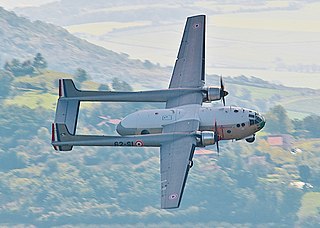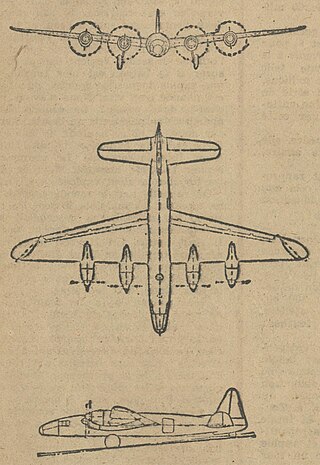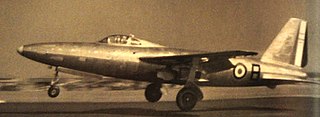
The SNCASE S.E.2010 Armagnac was a large French airliner of the late 1940s built by SNCASE (Sud-Est). The aircraft's disappointing performance and range prevented it from achieving commercial success. Although the SNCASE Armagnac did not have a sterling career, its passenger compartment design gave it a much roomier feel and greater capacity and foreshadowed the future wide-body jet airliners.

The Rolls-Royce RB.41 Nene is a 1940s British centrifugal compressor turbojet engine. The Nene was a complete redesign, rather than a scaled-up Rolls-Royce Derwent, with a design target of 5,000 lbf (22 kN), making it the most powerful engine of its era. First run in 1944, it was Rolls-Royce's third jet engine to enter production, and first ran less than 6 months from the start of design. It was named after the River Nene in keeping with the company's tradition of naming its jet engines after rivers.

The Nord Noratlas was a dedicated military transport aircraft, developed and manufactured by French aircraft manufacturer Nord Aviation.

The Aérospatiale N 262 is a French twin-turboprop high-wing airliner built first by Nord Aviation. The aircraft was also known as the Nord 262.

The Turbomeca Palas is a diminutive centrifugal flow turbojet engine used to power light aircraft. An enlargement of the Turbomeca Piméné, the Palas was designed in 1950 by the French manufacturer Société Turbomeca, and was also produced under licence by Blackburn and General Aircraft in the United Kingdom and Teledyne Continental Motors in the United States as the Continental Model 320.

The Sud-Ouest SO.6000 Triton was an early experimental French jet aircraft. It has the distinction of being the first indigenously-designed jet-powered aircraft to be flown by the nation, having been designed and manufactured during the 1940s by the French aircraft construction consortium SNCASO.

The Bréguet 761/763/765 are a family of 1940s and 1950s French double-deck transport aircraft produced by Bréguet Aviation. The aircraft were normally called the Deux-Ponts (Double-Decker) but it was not an official name.

The Breguet 941 was a French four-engine turboprop short takeoff and landing (STOL) transport aircraft developed by Breguet in the 1960s. Although widely promoted, both by Breguet in France and by McDonnell Aircraft and McDonnell Douglas in the United States, it was not built in large numbers; only one prototype and four production aircraft were built.

The Fouga CM.10 was an assault glider designed for the French Army shortly after World War II, capable of carrying 35 troops, later converted as a powered transport.

The Fiat G.12 was an Italian transport aircraft of World War II.

The Dassault MD.415 Communauté was a 1950s French twin-engined light turboprop transport monoplane built by Dassault Aviation. Only one prototype was built and flown.

The Potez 840 was a 1960s French four-engined 18-passenger executive monoplane, the last aircraft to use the Potez name.

The Hurel-Dubois HD.31, HD.32, and HD.34 were a family of civil aircraft produced in France in the 1950s, based on Maurice Hurel's high-aspect ratio wing designs.

The SNCASE SE.161 Languedoc was a French four-engined airliner produced by SNCASE (Sud-Est). Developed from the Bloch MB.160 and known in the late 1930s as the (SNCSO) Bloch MB.161, the SE.161 was in service with Air France and the French military after World War II.

The Sud-Ouest Corse was a French mail and passenger transport aircraft, built by SNCASO.

The SNCASO SO.9000 Trident is a French mixed-power interceptor aircraft built by aircraft manufacturer SNCASO during the 1950s. As part of a wider effort to re-build French military power during the late 1940s and to furnish France with advanced, new domestically produced designs, a request for a supersonic-capable point-defence interceptor aircraft to equip the French Air Force was issued to SNCASO. In response, the firm designed the mixed-propulsion Trident, powered by a single SEPR rocket engine, which was augmented by wingtip-mounted turbojet engines, and the Air Force ordered two prototypes.
The SNCASO SO.4000 was an experimental French twin-engine bomber of the 1950s. It was the first French jet bomber developed, but it never entered operational service.

The Nord 260, built in prototype form as the Max Holste MH.260 Super Broussard,, was a turboprop-powered, uprated version of the piston-engined Max Holste MH.250 Super Broussard, that was further developed into the Aérospatiale N 262.

The SNCASE SE-1010 was a late 1940s French photo-survey aircraft designed and built by SNCASE for the Institut Géographique National, one prototype was built but it crashed and the project was cancelled.

The Sud-Ouest SO.6020 Espadon (Swordfish) was a French post-war prototype interceptor designed and built by SNCASO during the late 1940s. The French Air Force judged the design a failure despite some records being set and cancelled plans to put it into service in 1951. Only four aircraft were built and they were later modified to serve as testbeds for the mixed rocket and turbojet-powered SNCASO SO.9000 Trident program. Only one badly damaged aircraft survives.



















